Jog Raj*, Hunor Farkaš, Svetlana Ćujić, Goran Grubješić, Jovana Dubajić, Zdenka Jakovčević and Marko Vasiljević
PATENT CO, DOO., Vlade Ćetković 1A, 24 211, Mišićevo, Serbia
*Corresponding author: [email protected]
Corn is one of the most important cereal crop grown globally and is essential for human and animal nutrition.
 However, its importance in the food and feed sectors is associated with concerns over contamination with mycotoxins -toxic secondary metabolites produced by certain species of fungi.
However, its importance in the food and feed sectors is associated with concerns over contamination with mycotoxins -toxic secondary metabolites produced by certain species of fungi.
These toxins pose a severe threat to food and feed safety due to their potential health impacts related to the teratogenic, nephrotoxic, hepatotoxic, neurotoxic, mutagenic, and immunosuppressive effects.
 In the last decades, mycotoxin contamination in feed and food chains has received attention due to new legislative limits and advancements in analytical techniques.
In the last decades, mycotoxin contamination in feed and food chains has received attention due to new legislative limits and advancements in analytical techniques.
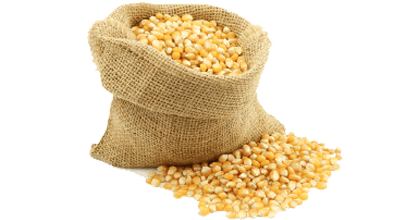

MYCOTOXIN ANALYSIS METHOD
The corn samples were delivered to PATENT CO. lab between September 2024 and February 2025.
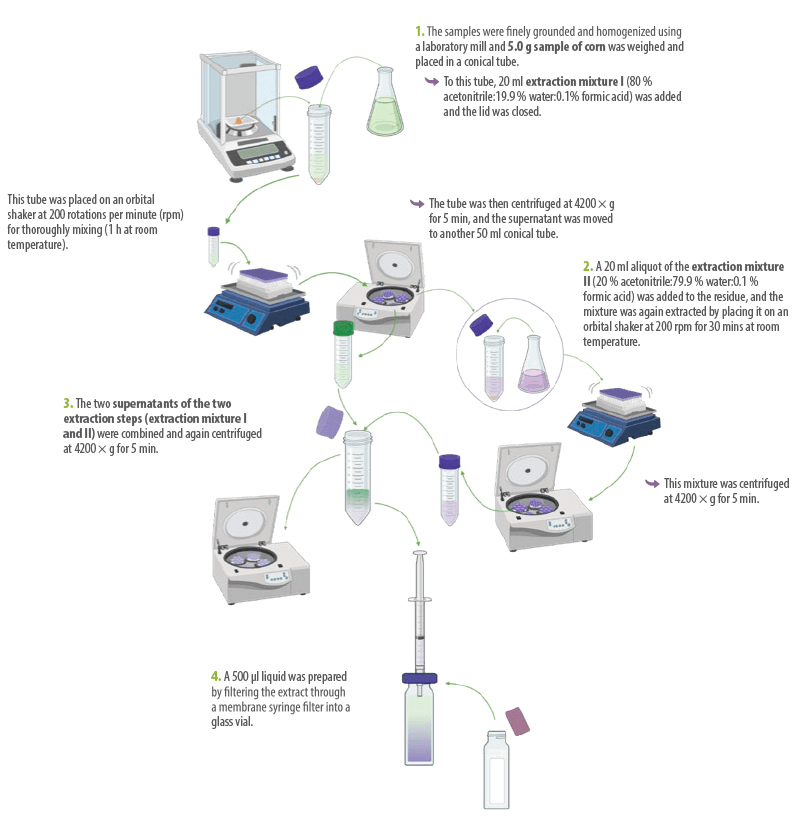
The corn samples from the mentioned countries were analysed using LC-MS/MS for the following mycotoxins:
European Union (EU)-regulated and related mycotoxins:
 Aflatoxins (AFB1, AFB2, AFG1, AFG2)
Aflatoxins (AFB1, AFB2, AFG1, AFG2) Deoxynivalenol (DON)
Deoxynivalenol (DON) Fumonisins (FB1, FB2, FB3)
Fumonisins (FB1, FB2, FB3) HT-2 toxin
HT-2 toxin Ochratoxin A (OTA)
Ochratoxin A (OTA) T-2 Toxin
T-2 Toxin Zearalenone (ZEN)
Zearalenone (ZEN)
Emerging mycotoxins:
 Beauvericin (BEA)
Beauvericin (BEA) Enniatins (ENNA, ENNA1, ENNB, ENNB1)
Enniatins (ENNA, ENNA1, ENNB, ENNB1) Fusaric acid (FA)
Fusaric acid (FA) Moniliformin (MON)
Moniliformin (MON)
Other mycotoxins:
 15-acetil deoxynivalenol (15-ADON)
15-acetil deoxynivalenol (15-ADON) 3-acetil deoxynivalenol (3-ADON)
3-acetil deoxynivalenol (3-ADON) 3-glucósido de desoxynivalenol (D-3-G)
3-glucósido de desoxynivalenol (D-3-G) Diacetoxyscirpenol (DAS)
Diacetoxyscirpenol (DAS) Neosolaniol (NEO)
Neosolaniol (NEO) Nivalenol (NIV)
Nivalenol (NIV) Zearalanone (ZAN)
Zearalanone (ZAN) α – zearalenol (α-ZEL)
α – zearalenol (α-ZEL) β – zearalenol (β-ZEL)
β – zearalenol (β-ZEL)
The mycotoxin results were expressed in μg/kg (parts per billion, ppb) relative to a feed with a moisture content of 12%.

RESULTS ![]()
Country wise, data on average, maximum, minimum, median, number of detected mycotoxins (%) per corn sample is shown as follows.
ARGENTINA 
The data in Figure 1 reveal that 98 % of the samples were contaminated with one or more types of mycotoxins, while 2 % of the samples did not contain any mycotoxins.
⇰ Among the contaminated samples, 11 % contained one, 11 % contained two, 9 % contained three, and 67 % contained more than three types of mycotoxins per sample.
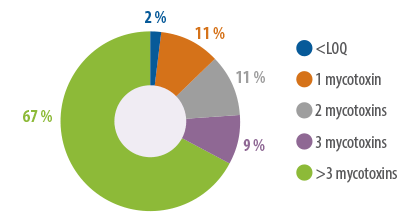
Figure 1. Number of mycotoxins (%) detected in Argentina’s corn samples from the 2024 harvest.
The data in Table 1 show that:
 Among the EU-regulated and related mycotoxins, AFB1 was detected in 2 % of the samples; DON (average 226.1 ppb) in 50 %; FB1, with an average of 1,183.7 ppb, in 62 %; FB2 in 59 %; FB3 in 53 %; and ZEN in 8 % of the tested samples.
Among the EU-regulated and related mycotoxins, AFB1 was detected in 2 % of the samples; DON (average 226.1 ppb) in 50 %; FB1, with an average of 1,183.7 ppb, in 62 %; FB2 in 59 %; FB3 in 53 %; and ZEN in 8 % of the tested samples. Among the emerging mycotoxins, BEA was found in 47 % of samples; FA, with an average of 51.6 ppb, in 86 %; ENNB in 14 %; and MON in 40 %.
Among the emerging mycotoxins, BEA was found in 47 % of samples; FA, with an average of 51.6 ppb, in 86 %; ENNB in 14 %; and MON in 40 %. Among the other mycotoxins, only 15-ADON was detected, found in 17 % of the samples.
Among the other mycotoxins, only 15-ADON was detected, found in 17 % of the samples.

Table 1. Mycotoxin contamination levels (ppb) in corn samples from Argentina in 2024.

BRAZIL 
In 2024, 100 % of corn samples from Brazil were contaminated with more than one mycotoxin.
⇰ The occurrence of three mycotoxins per sample was the most common.
The data in Table 2 show that:
 AFB1 (average 25.7 ppb) occurred in 20 % of the samples, AFB2 in 16 %, DON in 32 %, FB1 (average 737.8 ppb) in 100 %, FB2 in 96 %, and FB3 was detected in 80 % of the tested samples using LC-MS/MS.
AFB1 (average 25.7 ppb) occurred in 20 % of the samples, AFB2 in 16 %, DON in 32 %, FB1 (average 737.8 ppb) in 100 %, FB2 in 96 %, and FB3 was detected in 80 % of the tested samples using LC-MS/MS. Among the emerging mycotoxins, BEA and FA were each found in 88 % of the samples, while MON was detected in 40 %.
Among the emerging mycotoxins, BEA and FA were each found in 88 % of the samples, while MON was detected in 40 %.
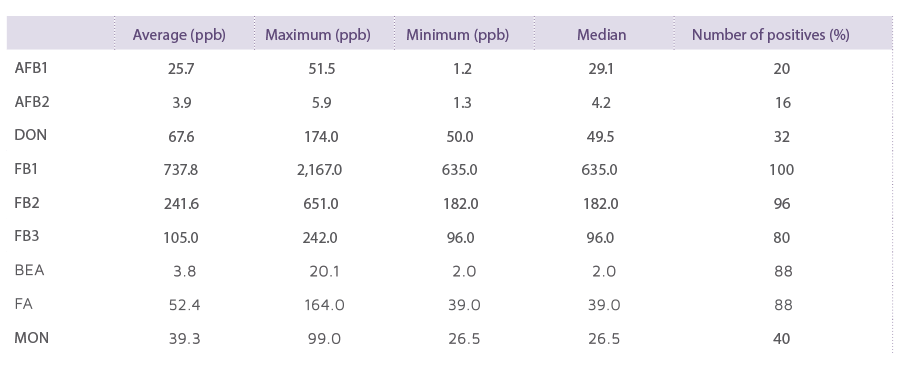
Table 2. Mycotoxin contamination levels (ppb) in corn samples from Brazil in 2024.

COLOMBIA
All the corn samples (100 %) received from different regions of Colombia were contaminated with more than three types of mycotoxins, demonstrating that the co-occurrence of multiple mycotoxins was the most common trend in these samples.
The data in Table 3 show that:
 AFB1 was found in 26 % and AFB2 in 11 % of the samples, while all the samples (100 %) showed the presence of DON (average 412.7 ppb) and FB1 (average 1,059.6 ppb). FB2 was detected in 85 % of the corn samples, FB3 in 81 %, and ZEN in 44 % of the tested samples.
AFB1 was found in 26 % and AFB2 in 11 % of the samples, while all the samples (100 %) showed the presence of DON (average 412.7 ppb) and FB1 (average 1,059.6 ppb). FB2 was detected in 85 % of the corn samples, FB3 in 81 %, and ZEN in 44 % of the tested samples. All the samples (100 %) showed the presence of the emerging mycotoxins BEA, FA, and MON, whereas 15-ADON was detected in 85 % of the samples.
All the samples (100 %) showed the presence of the emerging mycotoxins BEA, FA, and MON, whereas 15-ADON was detected in 85 % of the samples.
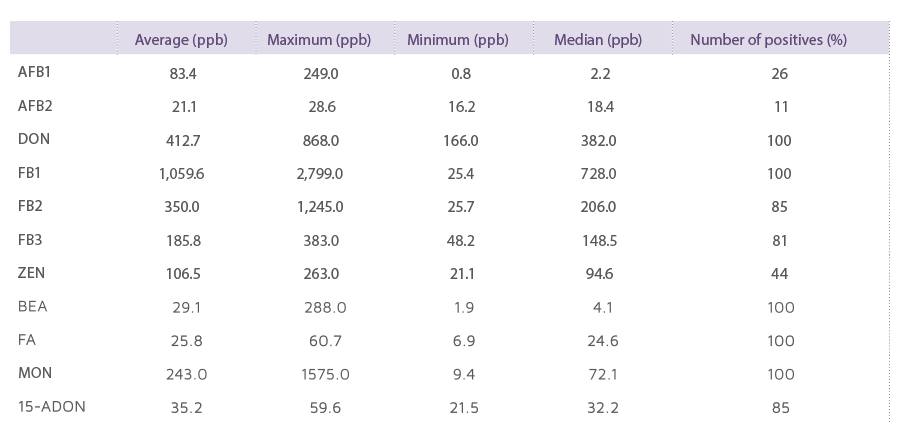
Table 3. Mycotoxin contamination levels (ppb) in corn samples from Colombia in 2024.
COSTA RICA
The analysis of corn samples received from Costa Rica using LC-MS/MS showed that all the samples (100 %) contained three or more types of mycotoxins, confirming co-contamination as a regular occurrence.
The data in Table 4 show that:
 AFB1 was found in 68 % of the samples, AFB2 in 59 %, and AFG1 in 36 %, while DON, with an average of 340.4 ppb, was detected in 77 %. FB1 (average 799.6 ppb) and FB2 were detected in 100 % of the samples, while FB3 and ZEN were detected in 95 % and 59 %, respectively.
AFB1 was found in 68 % of the samples, AFB2 in 59 %, and AFG1 in 36 %, while DON, with an average of 340.4 ppb, was detected in 77 %. FB1 (average 799.6 ppb) and FB2 were detected in 100 % of the samples, while FB3 and ZEN were detected in 95 % and 59 %, respectively. Among the emerging and other mycotoxins, ENNB occurred in 18 %, BEA in 82 %, FA in 91 %, and MON was detected in 100 % of the samples using LC-MS/MS. D-3-G was present in 23 %, and 15-ADON was detected in 45 % of the samples.
Among the emerging and other mycotoxins, ENNB occurred in 18 %, BEA in 82 %, FA in 91 %, and MON was detected in 100 % of the samples using LC-MS/MS. D-3-G was present in 23 %, and 15-ADON was detected in 45 % of the samples.
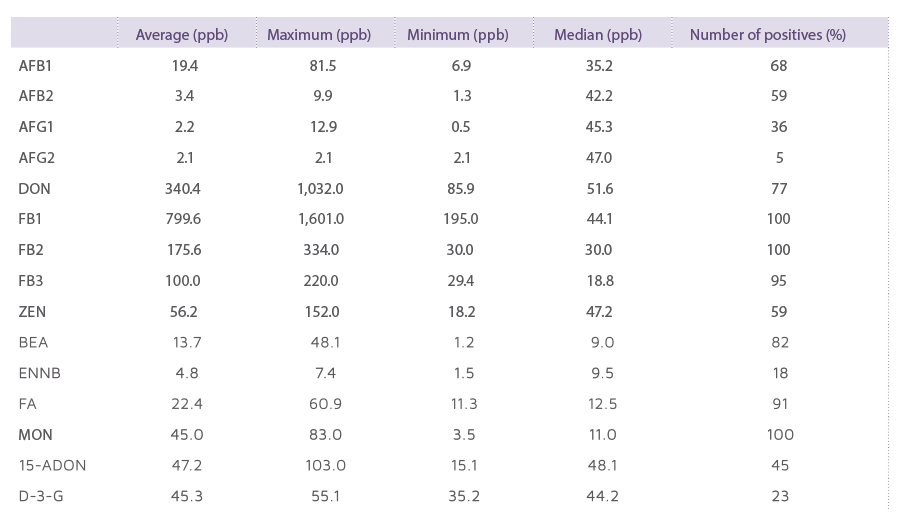
Table 4. Mycotoxin contamination levels (ppb) in corn samples from Costa Rica in 2024.
ECUADOR
All the samples (100 %) received from different regions of Ecuador in 2024 were contaminated with more than three types of mycotoxins, demonstrating a consistent co-occurrence pattern in the analysed corn samples.
The data in Table 5 show that:
 AFB1 (average 51.6 ppb) was detected in 95 % of the corn samples, AFB2 in 60 %, and AFG1 in 48 %. DON was found in 33 %, ZEN in 17 %, while FB1 (average 1,376.7 ppb), FB2, and FB3 were present in all the samples (100 %).
AFB1 (average 51.6 ppb) was detected in 95 % of the corn samples, AFB2 in 60 %, and AFG1 in 48 %. DON was found in 33 %, ZEN in 17 %, while FB1 (average 1,376.7 ppb), FB2, and FB3 were present in all the samples (100 %). Among the emerging and other mycotoxins, ENNB was detected in 21 % of the samples using LC-MS/MS-based analysis. FA (average 46.8 ppb) was present in all the samples (100 %), whereas MON was found in 74 %.
Among the emerging and other mycotoxins, ENNB was detected in 21 % of the samples using LC-MS/MS-based analysis. FA (average 46.8 ppb) was present in all the samples (100 %), whereas MON was found in 74 %.

Table 5. Mycotoxin contamination levels (ppb) in corn samples from Ecuador in 2024.
GUATEMALA
All the samples of corn (100 %) collected in Guatemala in 2024 were contaminated with more than three types of mycotoxins, indicating a consistent pattern of co-occurrence in the analysed samples.
The data in Table 6 show that:
 DON (average 321.1 ppb), FB1 (average 557.1 ppb), FB2, and FB3 were detected in 100 % of the tested samples using LC-MS/MS.
DON (average 321.1 ppb), FB1 (average 557.1 ppb), FB2, and FB3 were detected in 100 % of the tested samples using LC-MS/MS. Among the emerging and other mycotoxins, BEA was detected in 98 %, ENNB in 94 %, while FA (average 98.2 ppb) and MON were found in 100 % of the samples. 15-ADON (average 29.8 ppb) was detected in 47 % of the corn samples.
Among the emerging and other mycotoxins, BEA was detected in 98 %, ENNB in 94 %, while FA (average 98.2 ppb) and MON were found in 100 % of the samples. 15-ADON (average 29.8 ppb) was detected in 47 % of the corn samples.
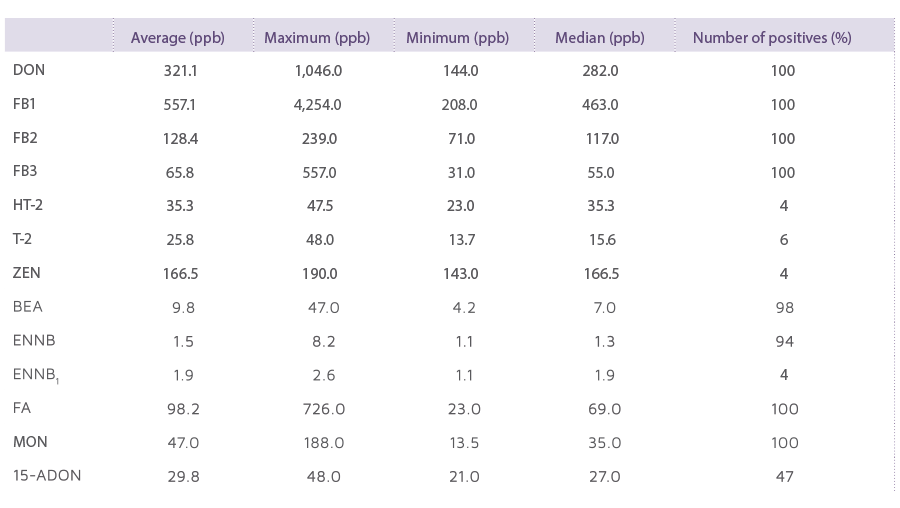
Table 6. Mycotoxin contamination levels (ppb) in corn samples from Guatemala in 2024.

MEXICO
All the corn samples (100 %) from Mexico in 2024 were contaminated with more than three types of mycotoxins per sample.
The data in Table 7 show that:
 AFB1 was detected in 25 % of the samples, AFB2 in 9 %, and DON, with an average of 498.5 ppb, was found in 85 %. FB1 (average 1,177.2 ppb) was detected in 97 % of the samples, FB2 in 90 %, FB3 in 87 %, and ZEN in 62 %.
AFB1 was detected in 25 % of the samples, AFB2 in 9 %, and DON, with an average of 498.5 ppb, was found in 85 %. FB1 (average 1,177.2 ppb) was detected in 97 % of the samples, FB2 in 90 %, FB3 in 87 %, and ZEN in 62 %. Among the emerging and other mycotoxins, BEA, FA, and MON were present in 90 %, 87 %, and 97 % of the samples, respectively. 15-ADON was detected in 68 % of the tested samples.
Among the emerging and other mycotoxins, BEA, FA, and MON were present in 90 %, 87 %, and 97 % of the samples, respectively. 15-ADON was detected in 68 % of the tested samples.
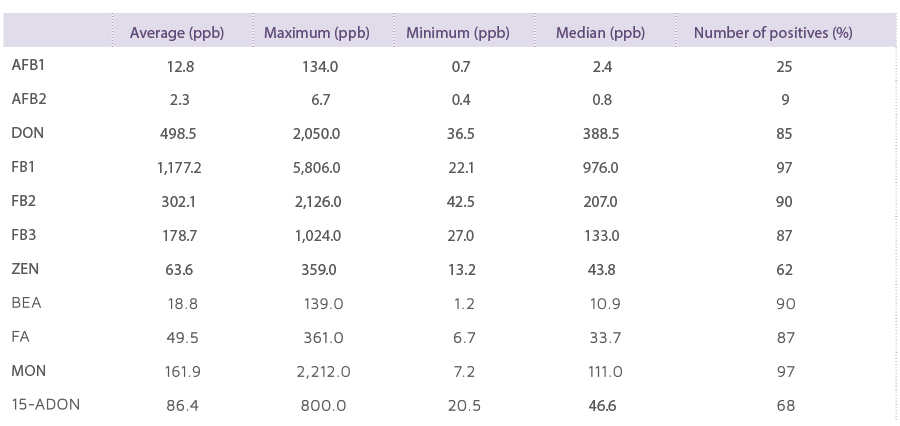
Table 7. Mycotoxin contamination levels (ppb) in corn samples from Mexico in 2024.

PERU
Corn samples collected in 2024 in Peru were contaminated with more than one type of mycotoxin, with nearly all the samples contained more than three types of mycotoxins.
The data in Table 8 show that:
 AFB1 was found in 44 % of the samples, and DON, with an average of 291.4 ppb, was detected in 94 %. FB1 (average 1,650.7 ppb) and FB2 were present in 100 % of the samples. FB3 was found in 88 %, and ZEN in 44 %.
AFB1 was found in 44 % of the samples, and DON, with an average of 291.4 ppb, was detected in 94 %. FB1 (average 1,650.7 ppb) and FB2 were present in 100 % of the samples. FB3 was found in 88 %, and ZEN in 44 %. Among the emerging and other mycotoxins, BEA was detected in 56 %, FA in 94 %, and MON in 63 % of the samples using LC-MS/MS. 15-ADON was present in 56 % of the samples.
Among the emerging and other mycotoxins, BEA was detected in 56 %, FA in 94 %, and MON in 63 % of the samples using LC-MS/MS. 15-ADON was present in 56 % of the samples.
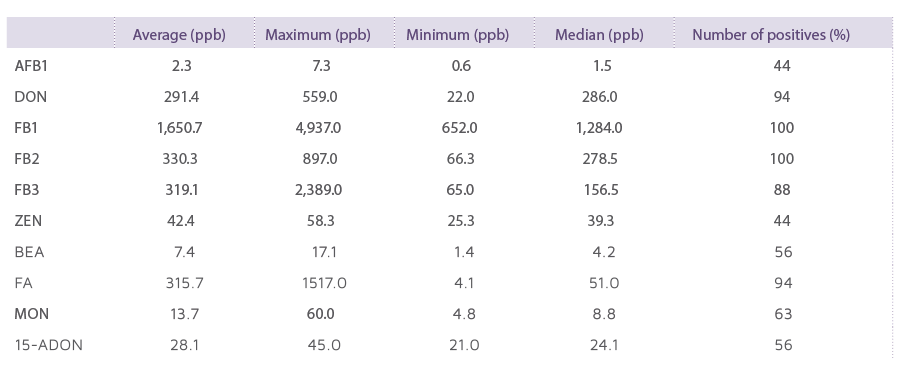
Table 8. Mycotoxin contamination levels (ppb) in corn samples from Peru in 2024.
USA
Of the corn samples collected in 2024 from the USA, 100 % of the samples showed co-occurrence of more than three types of mycotoxins per sample.
The data in Table 9 show that:
 DON, with an average of 585.1 ppb, was found in 98 % of the samples. FB1 (average 740.5 ppb) and FB2 were detected in 91 %, FB3 in 84 %, HT-2 toxin in 20 %, T-2 toxin in 13 %, and ZEN in 22 % of the samples.
DON, with an average of 585.1 ppb, was found in 98 % of the samples. FB1 (average 740.5 ppb) and FB2 were detected in 91 %, FB3 in 84 %, HT-2 toxin in 20 %, T-2 toxin in 13 %, and ZEN in 22 % of the samples. Among the emerging and other mycotoxins, BEA was detected in 87 %, FA in 96 %, MON in 93 %, and 15-ADON in 62 % of the tested samples.
Among the emerging and other mycotoxins, BEA was detected in 87 %, FA in 96 %, MON in 93 %, and 15-ADON in 62 % of the tested samples.

Table 9. Mycotoxin contamination levels (ppb) in corn samples from USA in 2024.

CONCLUSIONS 
In the 2024 corn survey, corn samples were received from Argentina, Brazil, Colombia, Costa Rica, Ecuador, Guatemala, Mexico, Peru, and the USA, and were analysed for EU-regulated, emerging, and other mycotoxins using LC-MS/MS.
The country-wise mycotoxin results are shown in Table 10.
The results showed that 87 % of corn samples from Argentina and 100 % of corn samples from the remaining eight countries (Brazil, Colombia, Costa Rica, Ecuador, Guatemala, Mexico, Peru, and the USA) were contaminated with more than one type of mycotoxin.
These multiple mycotoxins can have additive or synergistic negative effects on animals.
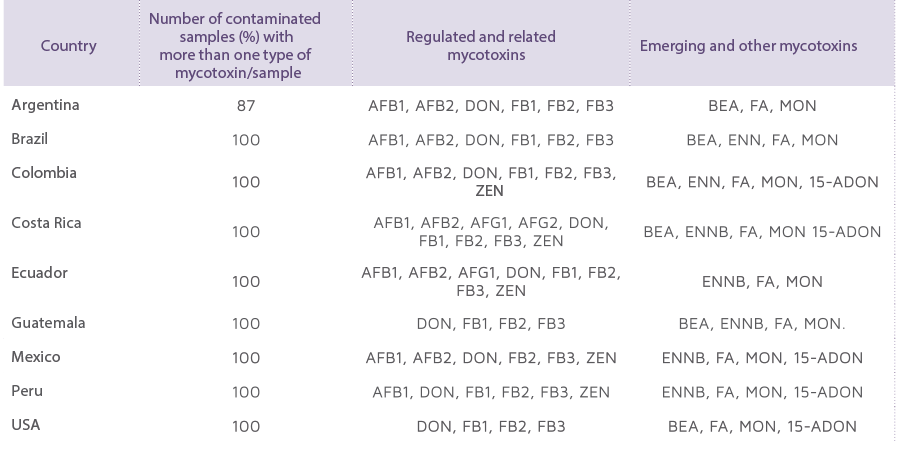
Table 10. Summary of mycotoxin results for Argentina, Brazil, Colombia, Costa Rica, Ecuador, Guatemala, Mexico, Peru, and the USA detected in 2024 harvested corn using LC-MS/MS.
Aflatoxins, along with other emerging and regulated mycotoxins (DON, FA, FB1, FB2, FB3, and ZEN), were detected in corn samples from Brazil, Costa Rica, Colombia, Ecuador, Mexico, and Peru.
This study provides valuable insights into the co-occurrence and co-contamination of aflatoxins, emerging mycotoxins, and Fusarium-produced mycotoxins in the majority of 2024 harvested corn samples from the USA and LATAM countries.
Aflatoxins—particularly AFB1—posed the most significant threat, frequently exceeding regulatory limits for human and animal consumption.
Fumonisins also remained a critical concern in recent years, with high levels potentially exacerbated by warmer temperatures during the growing season.

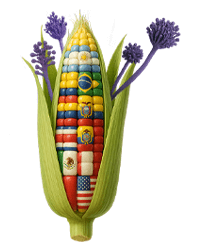


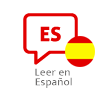
 Micotoxicosis prevention
Micotoxicosis prevention